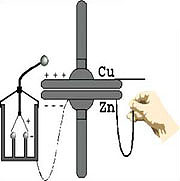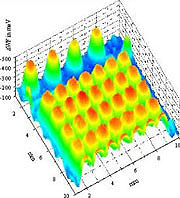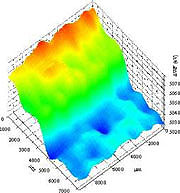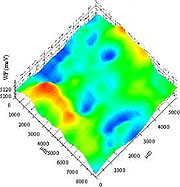 The original apparatus of
The original apparatus of
Lord Kelvin.
 Cr deposited on Si(100)
Cr deposited on Si(100)
Sample courtesy of
Dr. Bert Lagel,
University of South Florida.
 100nm ITO on glass - Sample courtesy of Dr. Dmitry Poplavskyy, OSRAM Opto Semiconductors Inc
100nm ITO on glass - Sample courtesy of Dr. Dmitry Poplavskyy, OSRAM Opto Semiconductors Inc
 100nm PEDOT:PSS - Sample courtesy of Dr. Dmitry Poplavskyy, OSRAM Opto Semiconductors Inc.
100nm PEDOT:PSS - Sample courtesy of Dr. Dmitry Poplavskyy, OSRAM Opto Semiconductors Inc.
Welcome to the Kelvin Probe information site
The Kelvin Probe is a non-contact, non-destructive measurement device used to investigate properties of materials.
It is based on a vibrating capacitor and measures the work function difference or, for non-metals, the surface potential, between a conducting specimen and a vibrating tip.
The work function is an extremely sensitive indicator of surface condition and is affected by adsorbed or evaporated layers, surface reconstruction, surface charging, oxide layer imperfections, surface and bulk contamination, etc.
The Kelvin method was first postulated by the renowned Scottish scientist Lord Kelvin in 1861. Shown here is a picture of his original apparatus.
Ideas and examples
This website provides information on the science behind the Kelvin Probe, ideas for applications, examples of measurements and some comments on current apparatus available.
All are compiled by Professor Iain D. Baikie who has extensive experience in the technique.
If you did not find what you were looking for please contact us directly. We welcome any comments and questions related to the Kelvin Probe or this site.
Kelvin Probe Webinar, World Wide Broadcast
February 2010
In February 2010 Professor Iain Baikie in conjunction with the publication 'Thin Solid Film' headed up an expert panel presenting an educational webinar introducing viewers
to the principle of the Kelvin Probe technique,
explaining how it works, the information it provides
and how this can be interpreted through the use of
examples and typical applications in Materials Science.
Attendees discovered the advantages this highly sensitive research tool can offer and had the opportunity to ask any questions relevant to the Kelvin Probe technique
and their current research requirements.
A recording of this event is now available to watch at your leisure:
Introduction to the Traditional Kelvin Probe for
High Resolution Work Function Measurements
recorded live on
Thursday 25th February

|

Single Electron Transistor Device results scan
Kelvin Probe 50micron tip measuring a Single Electron Transistor Device
Scanning Kelvin Probe
UHV Kelvin Probe
Solar Panels
Scanning Kelvin Probe
|
